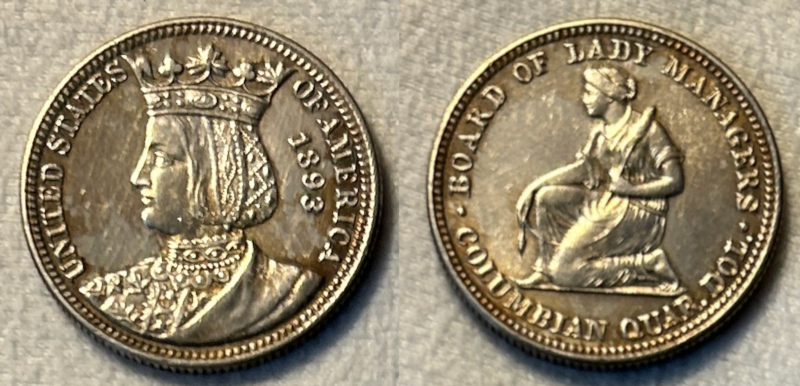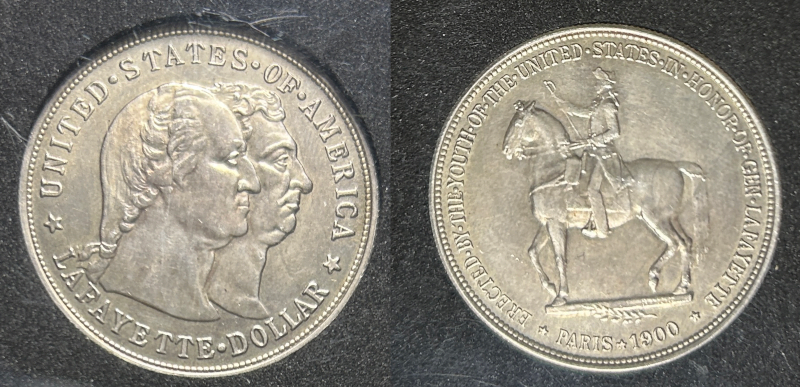The things we do for a free vacation.
Some people enter random drawings. Some sit through timeshare presentations. Some even cash in their credit card points.
Robert J. Thompson got a commemorative silver dollar made honoring one of the greatest heroes of the Revolutionary War.
Sure. Thompson’s stated reason for proposing a coin honoring Marie-Joseph Paul Yves Roch Gilbert du Motier, Marquis de Lafayette was an honorable one. Thompson had long admired the Frenchman, who had played an important role in helping the American colonies win their independence from Great Britain. As the story goes, Thompson read a story about how Lafayette’s grave had been marked with a simple stone slab without any note of gratitude from the country he helped free. The Chicagoan Thompson saw an opportunity to rectify this and proposed dedicating a monument to the Frenchman at the 1900 World’s Fair in Paris.
But more than a decade later, he wrote that he was really just hoping to score a free trip to Paris. After all, the brains and inspiration behind such a monument would, surely, get to attend the dedication ceremony as a distinguished guest of the U.S. government, right?
While I was still a boy certain moral and family obligations made it appear to me fitting and necessary that I make a trip to Europe. Without either money, profession, or business I had, like thousands of our young men, gotten married when I was little more than a boy, eighteen years of age, and we could not make the trip that I intended without either money or position. So what had to be done?
Quoted by David Provost, “Commemorative Stories: The 1900 Lafayette Dollar Coin – Part I,” Coin Week, Feb. 3, 2015.
Of course, it’s one thing to want a monument and quite another to actually get one authorized, funded, and built – especially in time for an major international event. Luckily for him, he had some friends who had experience in that area. Thompson had befriended Ferdinand Peck, a prominent Chicago businessman who had served as founding member of the World’s Columbian Exposition Company (also known as the Chicago World’s Fair, which was held in 1893). That exposition had been funded, in part, by the issuance of two commemorative coins, a half dollar featuring Christopher Columbus and a quarter featuring Queen Isabella.

To help fund the proposed Lafayette monument, Peck, Thompson and a group of other prominent Americans including Secretary of State (and future Supreme Court Justice) William R. Day and Comptroller of the Currency (and future Vice President) Charles Dawes, did what many others would do in the ensuing decades and proposed the minting of a commemorative coin.
The commission originally proposed the minting of 100,000 silver half dollars – similar to the Columbus half dollar from 1892 and 1893. According to Coin Week, Thompson pushed for a dollar coin, arguing that the larger surface area would allow for more artistic possibilities. With minimal debate, Congress authorized the minting of 50,000 silver dollars by tacking on an amendment to an appropriations bill for fiscal year 1900. President William McKinley signed it into law on March 3, 1899 – a year and change before the planned dedication of the monument, which was set for the symbolically important date of July 4, 1900.
When it came to designing the coin, the Mint made several interesting decisions. According to Dickerman’s United States Treasury Counterfeit Detector, Mint officials considered numerous designs, including one with George Washington on one side and Lafayette on the other, one with the busts of Washington, Lafayette, Abraham Lincoln and Ulysses S. Grant on the obverse, and Thompson’s favored choice, a larger-sized coin that could fit the text of Lafayette’s prayer on the reverse. Chief Engraver Charles Edward Barber, who was best known for his Liberty Head themed nickels, dimes, quarters and half dollars that were minted from 1892 to 1916, chose a design featuring conjoined busts of Washington and Lafayette on the obverse and an image of the proposed monument on the reverse.
Using Washington was noteworthy – while he may be a ubiquitous presence on our currency now, our first president had never officially appeared on a U.S. coin. Indeed, it had been taboo to use images of real people on U.S. coins – and Washington, in particular, had turned down a chance to appear on the first U.S. coins because he didn’t want to seem like a monarch.

But that wasn’t the main controversy. The chief engraver stated he based the Washington bust on a 1785 medal by Jean-Antoine Houdon, and the Lafayette image on an 1824 medal by François-Augustin Caunois. However, numismatists immediately accused Barber of copying Peter L. Krider’s 1881 Yorktown Centennial Medal, which also featured conjoined busts of Washington and Lafayette – and not doing a very good job of it. Ron Guth, founder of Professional Coin Grading Service (PCGS), called Barber’s design “a travesty of Krider’s extremely detailed high-relief artistry.” Art historian Cornelius Vermeule compared the coin unfavorably to its predecessors, arguing “the Lafayette dollar lacks the quaint, dated appeal of the Isabella quarter or the amusing originality of the Columbian half-dollar. David Provost, writing for Coin Week, found “Krider’s depiction of Washington and Lafayette appears more life-like and engaging” and argued that “[s]uch a level of execution on the Lafayette dollar would have raised its artistic merits many fold.”
Nevertheless, the Barber’s design went forward and the coin was struck in 1899 – the 100th anniversary of George Washington’s death. But that presented another problem. The Mint wanted the date to read “1900” since that was when the monument would be dedicated. However, there were rules against antedating coins. As such, the Mint decided on a workaround – there would be no actual date on the coin, per se. Instead, the reverse would simply read “erected by the youth of the United States in honor of Gen. Lafayette, Paris 1900” in a circle along the edge of the coin with the date appearing at the bottom, where it normally would be. As such, most numismatists refer to this coin as a “1900 Lafayette Dollar” even though it’s, technically, an undated coin.
This coin ended up being a failure of sorts. Of the 50,000 struck, approximately 36,000 were sold and the remaining 14,000 were melted down. Demand was so low that, for several years, it actually sold at auctions for less than its original retail price of $2.
That would change. Today, the coin is a highly sought-after collector’s item and prices can even hit four digits. I got my coin several years ago, before the spike in silver prices following the Great Recession, so I didn’t pay nearly that much (although it wasn’t cheap!). This has become one of my favorite coins in my collection; between the historical significance of this coin, its unique design (I didn’t think it was as bad as some of the art experts said) and its status as the only commemorative silver dollar of the pre-1982 era, it was definitely worth the investment!
And it was definitely worth it for Robert Thompson. As hoped for, he was named a special envoy for the U.S. and got his trip to Paris for the dedication of the monument, where he presented one of the coins to French President Émile Loubet.
I voice the sentiments of my countrymen when I express the hope that this memorial dollar stamped with the likenesses of Washington and Lafayette may remain always as it is to day an emblem of the amity of purpose of the two great Republics of the world.
Thompson’s address at the dedication of the Lafayette Monument in Paris, 1900.
And, as we’ve seen, things have been just peachy between the U.S. and France ever since…

